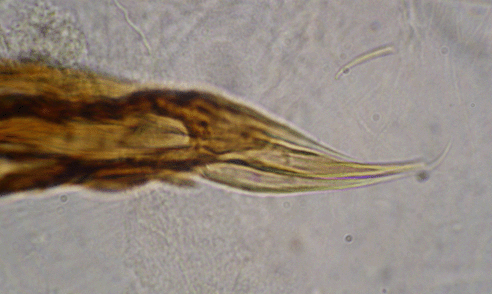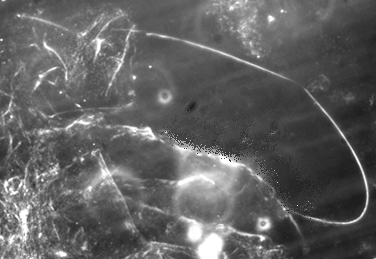Species 3d. C. nr. annularius sensu Strenzke (1959)In BOLD Bin: BOLD:ABA9112 Currently European specimens called C. annularius are listed in 3 other BOLD bins: BOLD:AAU4046; BOLD:AAU4047 and BOLD:AAW3973I am grateful to Prof. P. Michailova for pointing out that this North American species is identical to material of C. annularius from Russia. Adult AR 4.0 (abt 3.72-4.28) Wing length 3.9 (abt 3.6-4.2) mm, width about 1.3 mm. Thorax greyish yellow, bands black or red-brown with more or less darker flecking. Setae - acrostichal abt 18-27; dorsolateral abt. 27-36; prealar about5-8; supra alar abt 1-2; scutellar abt 33-48. Legs with tarsi darkened. LR1 abt 1.35-1.45; F1/Ti1 abt 1.04-1.08. Adbomen with most of seg I yellow brown, segs II-V darker, II-IV with anal border extended medially. Hypopygium with abt 4 setae in patch in centre of TIX; Superior volsella of E-type (variable); Inferior volsella markedly narrowed at the tip, gonostylus narrowing gently over posterior half.  Adult female of C. species 3d.From BOLD database: specimen A08z+1337961340 Female (from specimens in BOLD): Pupa: some pupal characters known from a late prepupa.  Anal fringe with about 94 setae in multiple rows. Fourth instar larva a medium length plumosus-melanotus-type; length 15.3-17.8 mm, very similar to that of sp. 3b but gular region darker (posterior 2/3 dark to very dark, extending beyond width of mentum and generally higher at edges), frontoclypeus normally pale, but occasionally very slightly darkened or with a streak along the middle and on edges. Ventral tubules relatively long, about equal in length or anterior pair longer (ant. 0.92-1.80, 1.42 mm; 0.92-1.80, 1.34 mm); lateral tubules variable (about 160-240 µm). Anal tubules relatively short (420-640 µm) with no constriction, about 2-3.2 times longer than wide, ventral pair usually shorter.  Anal tubule of C. species 3d. Mentum (Figs. e & f) with 4th laterals only slightly reduced (type I-ii), central trifid tooth somewhere between type IB and III, with c2 teeth separated to about 1/3 depth of c1 tooth, which can also look like type IIA if worn. Ventromental plates (Fig. g) about 237-270 µm long, 3.5-4 times wider than deep, 0.99-1.07 times the mentum width; IPD about 40% of width of mentum, with about 42-43 striae; VMR 0.27-0.30. Premandible (Fig. b) closest to type D with with relatively broad inner tooth about 3.5-4 times wider than the outer;teeth relatively short, only about twice as long as the greatest width. Pecten epipharyngis (Fig. a) with about 16-17 pointed teeth. Antenna (Fig. c) with basal segment about 0.35-0.4 of VHL, about 3.5-3.6 times longer than wide, RO just under half way up the segmant; AR about 2.2-2.4, relative length of segments (µm) 152 : 35 : 9 : 15 : 8. Distance between the antennal bases less than that between the S4 setae, which are separated by about 78-81% of the FC width. Mandible (Fig. d) with 3rd inner tooth relatively well separated, but still relatively pale (type II-IIIB), 16-19 grooves on outer surface at base; 11-16 taeniae in Pecten mandibularis; MTR 0.21-0.34. Cytology: 4 polytene chromosomes with the thummi arm combination AB, CD, EF, G. h'annA2: 1 - 2c, 10 - 12a, 13ba, 4a-c, 2g-d, 9 - 4d, 2h - 3, 12cb, 13 c- 19 as h'antA1, h'pluA2. Found: Alberta - Amisk Lake; Astotin Lake, Elk Island N.P. (53.685°N, 112.86°W), Two Hills (53.7104°N, 111.744°W) (both BOLD) Lakes and dams Larva very similar to that of sp. 3b but gular region darker, frontoclypeus pale, and lateral projections shorter. Some information on arm F published by Martin (1979), and Wülker, Devai & Devai (1989), under the name Species 9. Some larval characters given in Hilsenhoff & Narf (1968) as Chironomus n.sp. D. Karyotype described by Kiknadze et al. (2012) and (2016). |
Modified: 24 January 2024
Access: Unrestricted
Copyright © 2000-2024, Jon Martin.